Nationality American Playing career Children Josh Maravich Height 1.96 m | Listed weight 197 lb (89 kg) Role Basketball player Listed height 6 ft 5 in (1.96 m) Name Pete Maravich | |
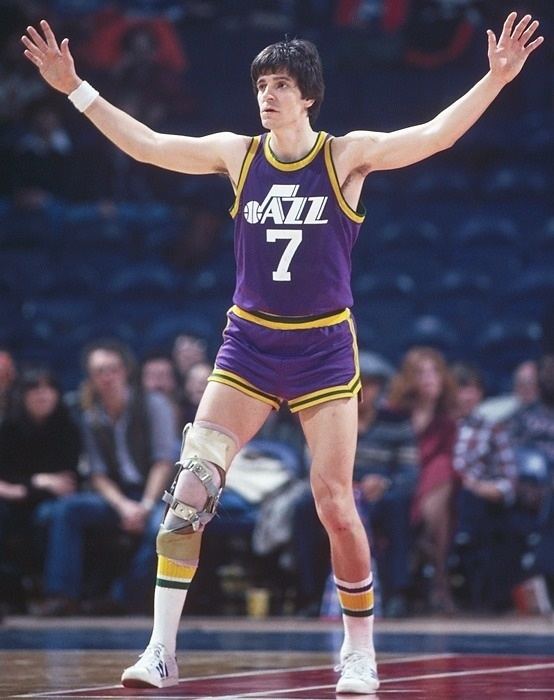 | ||
NBA draft 1970 / Round: 1 / Pick: 3rd overall Similar People Press Maravich, Josh Maravich, Oscar Robertson, Jerry West, Larry Bird | ||
Ultimate college pistol pete maravich lsu mix
Peter Press Maravich (June 22, 1947 – January 5, 1988), nicknamed Pistol Pete, was an American professional basketball player. He was born in Aliquippa, Pennsylvania, part of the Pittsburgh metropolitan area, and raised in the Carolinas. Maravich starred in college at Louisiana State University (LSU) and played for three NBA teams until injuries forced his retirement in 1980. He is the all-time leading NCAA Division I scorer with 3,667 points scored and an average of 44.2 Points per game. All of his accomplishments were achieved before the three-point line and shot clock were introduced to NCAA basketball and despite being unable to play varsity as a freshman under then-NCAA rules. One of the youngest players ever inducted into the Naismith Memorial Basketball Hall of Fame, Maravich was cited by the Hall as "perhaps the greatest creative offensive talent in history". In an April 2010 interview, Hall of Fame player John Havlicek said that "the best ball-handler of all time was Pete Maravich".
Contents
- Ultimate college pistol pete maravich lsu mix
- HD Pistol Pete Maravich TOP 20 PLAYS 2016
- Early life
- LSU
- Atlanta Hawks
- New Orleans Jazz
- Final season
- Later life and death
- Legacy
- Memorabilia
- Honors books films and music
- Collegiate awards
- Collegiate records
- NBA awards
- NBA records
- References
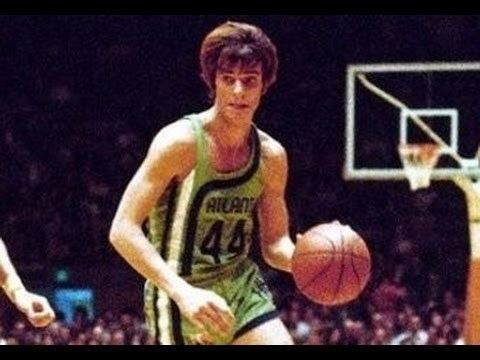
[HD] Pistol Pete Maravich - TOP 20 PLAYS Ⓒ 2016
Early life

Pete Maravich was born to Petar "Press" Maravich (1915–1987) and Helen Gravor Maravich (1925–1974) in Aliquippa, a steel town in Beaver County in western Pennsylvania, near Pittsburgh. Maravich amazed his family and friends with his basketball abilities from an early age. He enjoyed a close but demanding father–son relationship that motivated him toward achievement and fame in the sport. Maravich's father was the son of Serbian immigrants and a former professional player-turned-coach. He showed him the fundamentals starting when he was seven years old. Obsessively, Maravich spent hours practicing ball control tricks, passes, head fakes, and long-range shots.
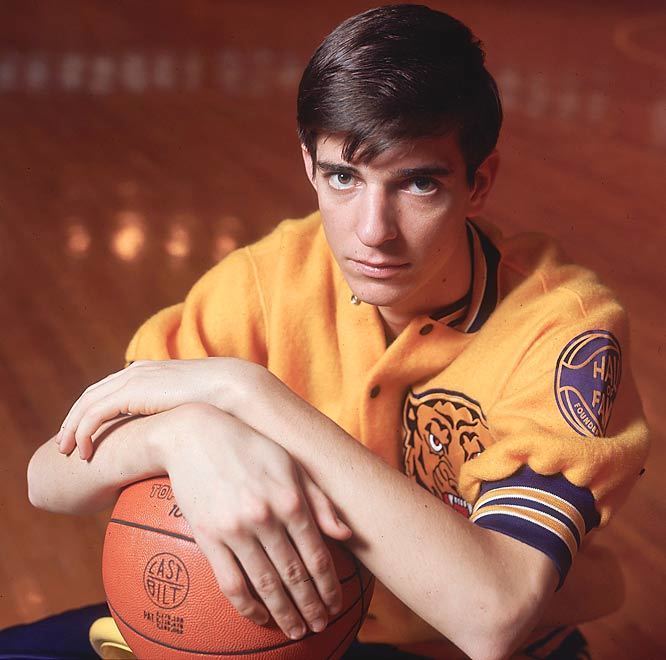
Maravich played high school varsity ball at Daniel High School in Central, South Carolina, a year before being old enough to attend the school. While at Daniel from 1961 to 1963, Maravich participated in the school's first-ever game against a team from an all-black school. In 1963 his father departed from his position as head basketball coach at Clemson University and joined the coaching staff at North Carolina State University. The Maravich family's subsequent move to Raleigh, North Carolina, allowed Pete to attend Needham B. Broughton High School. His high school years also saw the birth of his famous moniker. From his habit of shooting the ball from his side, as if he were holding a revolver, Maravich became known as "Pistol" Pete Maravich. From there "Pistol" Maravich graduated from Needham B. Broughton High School in 1965 and then attended Edwards Military Institute, where he averaged 33 points per game.
LSU
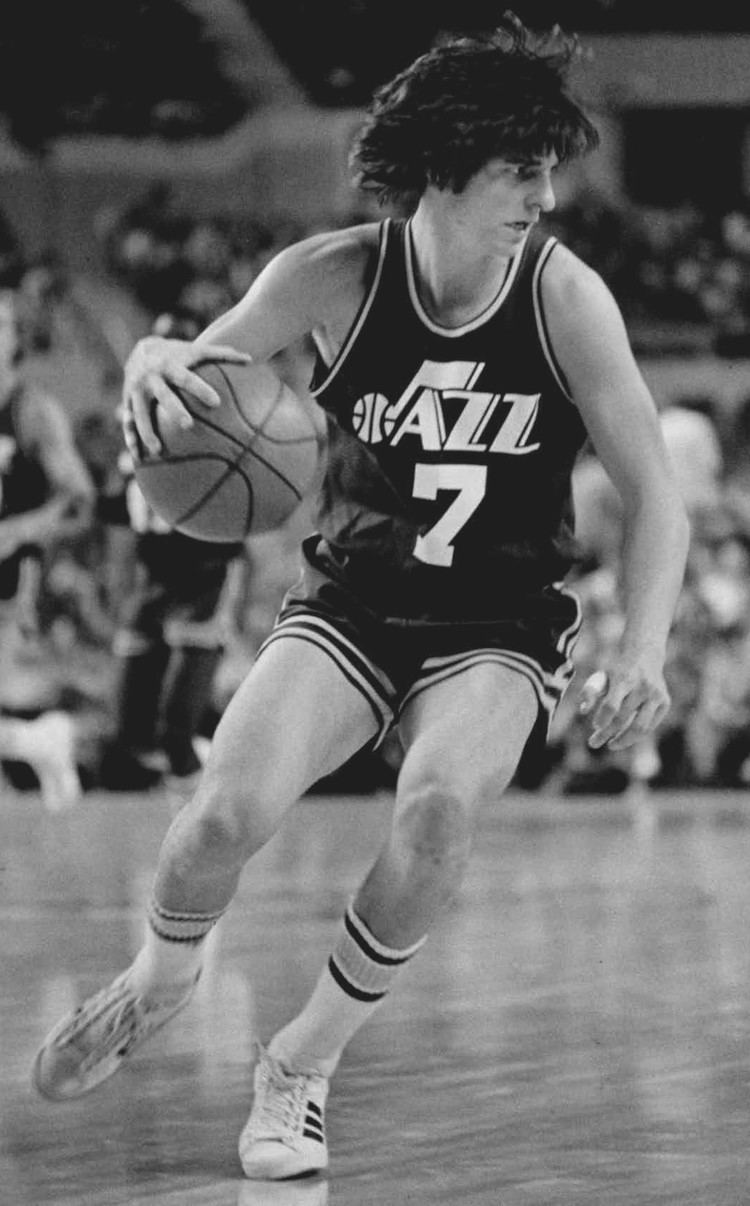
Later in life Maravich would tell friends he always desired to play basketball for West Virginia University and was originally ready to be a Mountaineer, but his father was the head coach for LSU Men's Basketball and offered him a spot at the school. At that time NCAA rules prohibited first-year students from playing at the varsity level, which forced Maravich to play on the freshman team. In his first game, Maravich put up 50 points, 14 rebounds and 11 assists against Southeastern Louisiana College.
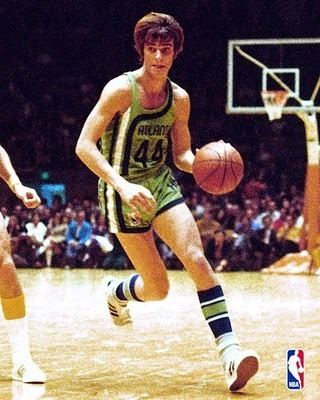
In only three years playing on the varsity team (and under his father's coaching) at LSU, Maravich scored 3,667 points—1,138 of those in 1968, 1,148 in 1969, and 1,381 in 1970—while averaging 43.8, 44.2, and 44.5 points per game. For his collegiate career, the 6'5" (1.96 m) guard averaged 44.2 points per game in 83 contests and led the NCAA in scoring for each of his three seasons.

Maravich's long-standing collegiate scoring record is particularly notable when three other factors are taken into account:
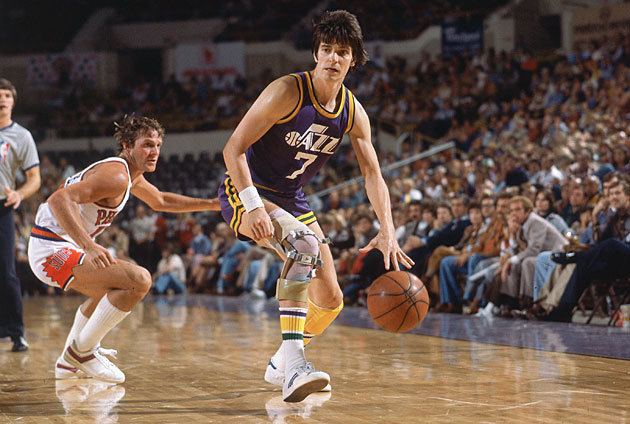
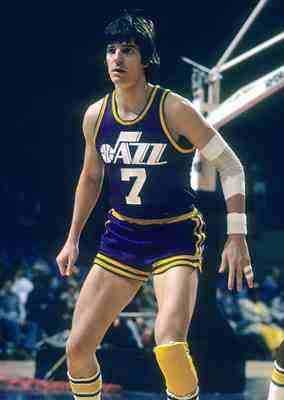
More than 40 years later, however, many of his NCAA and LSU records still stand. Maravich was a three-time All-American. Though he never appeared in the NCAA tournament, Maravich played a key role in turning around a lackluster program that had posted a 3–20 record in the season prior to his arrival. Pete Maravich finished his college career in the 1970 National Invitation Tournament, where LSU finished fourth.
Atlanta Hawks
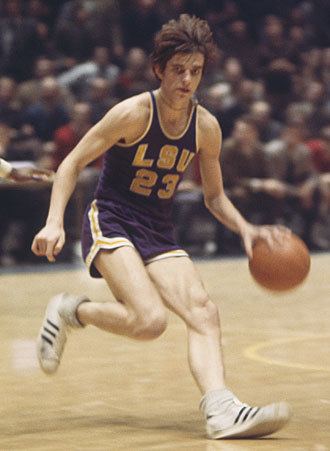
The Atlanta Hawks selected Maravich with the third pick in the first round of the 1970 NBA draft, where he played for coach Richie Guerin. He was not a natural fit in Atlanta, as the Hawks already boasted a top-notch scorer at the guard position in Lou Hudson. In fact, Maravich's flamboyant style stood in stark contrast to the conservative play of Hudson and star center Walt Bellamy. And it did not help that many of the veteran players resented the $1.9 million contract that Maravich received from the team—a very large salary at that time.
Maravich appeared in 81 games and averaged 23.2 points per contest—good enough to earn NBA All-Rookie Team honors. And he managed to blend his style with his teammates, so much so that Hudson set a career high by scoring 26.8 points per game. But the team stumbled to a 36–46 record—12 wins fewer than in the previous season. Still, the Hawks qualified for the playoffs, where they lost to the New York Knicks in the first round.
Maravich struggled somewhat during his second season. His scoring average dipped to 19.3 points per game, and the Hawks finished with another disappointing 36–46 record. Once again they qualified for the playoffs, and once again they were eliminated in the first round. However, Atlanta fought hard against the Boston Celtics, with Maravich averaging 27.7 points in the series.
Maravich erupted in his third season, averaging 26.1 points (5th in the NBA) and dishing out 6.9 Assists per game (6th in the NBA). With 2,063 points, he combined with Hudson (2,029 points) to become only the second set of teammates in league history to each score over 2,000 points in a single season. The Hawks soared to a 46–36 record, but again bowed out in the first round of the playoffs. However, the season was good enough to earn Maravich his first-ever appearance in the NBA All-Star Game, and also All-NBA Second Team honors.
The following season (1973–74) was his best yet—at least in terms of individual accomplishments. Maravich posted 27.7 points per game—second in the league behind Bob McAdoo—and earned his second appearance in the All-Star Game. However, Atlanta sank to a disappointing 35–47 record and missed the postseason entirely.
New Orleans Jazz
In the summer of 1974, an expansion franchise was preparing for its first season of competition in the NBA. The New Orleans Jazz were looking for something or someone to generate excitement among their new basketball fans. With his exciting style of play, Maravich was seen as the perfect man for the job. Additionally, he was already a celebrity in the state due to accomplishments at LSU. To acquire Maravich, the Jazz traded two players and four draft picks to Atlanta.
The expansion team struggled mightily in its first season. Maravich managed to score 21.5 points per game, but shot a career-worst 41.9 percent from the floor. The Jazz posted a 23–59 record, worst in the NBA.
Jazz management did its best to give Maravich a better supporting cast. The team posted a 38–44 record in its second season (1975–76) but did not qualify for postseason play, despite the dramatic improvement. Maravich struggled with injuries that limited him to just 62 games that season, but he averaged 25.9 points per contest (third behind McAdoo and Kareem Abdul-Jabbar) and continued his crowd-pleasing antics. He was elected to the All-NBA First Team that year.
The following season (1976–77) was his most productive in the NBA. He led the league in scoring with an average of 31.1 points per game. He scored 40 points or more in 13 different games, and 50 or more in 4 games. His 68-point masterpiece against the Knicks was at the time the most points ever scored by a guard in a single game, and only two players at any position had ever scored more: Wilt Chamberlain and Elgin Baylor. Baylor was head coach of the Jazz at that time.
Maravich earned his third all-star game appearance and was honored as All-NBA First Team for the second consecutive season.
The following season, injuries to both knees forced him to miss 32 games during the 1977–78 season. Despite being robbed of some quickness and athleticism, he still managed to score 27.0 points per game, and he also added 6.7 assists per contest, his highest average as a member of the Jazz. Many of those assists went to new teammate Truck Robinson, who had joined the franchise as a free agent during the off-season. In his first year in New Orleans, he averaged 22.7 points and a league-best 15.7 Rebounds per game. His presence prevented opponents from focusing their defensive efforts entirely on Maravich, and it lifted the Jazz to a 39–43 record—just short of making the club's first-ever appearance in the playoffs.
Knee problems plagued Maravich for the rest of his career. He played in just 49 games during the 1978–79 season. He scored 22.6 points per game that season and earned his fifth and final All-Star appearance. But his scoring and passing abilities were severely impaired. The team struggled on the court, and faced serious financial trouble as well. Management became desperate to make some changes. The Jazz traded Robinson to the Phoenix Suns, receiving draft picks and some cash in return. However, in 1979, team owner Sam Battistone moved the Jazz to Salt Lake City.
Final season
The Utah Jazz began play in the 1979–80 season. Maravich moved with the team to Salt Lake City, but his knee problems were worse than ever. He appeared in 17 games early in the season, but his injuries prevented him from practicing much, and new coach Tom Nissalke had a strict rule that players who didn't practice were not allowed to play in games. Thus, Maravich was parked on the bench for 24 straight games, much to the dismay of Utah fans and to Maravich himself. During that time, Adrian Dantley emerged as the team's franchise player.
The Jazz placed Maravich on waivers in January 1980. He signed with the Celtics, the top team in the league that year, led by rookie superstar Larry Bird. Maravich adjusted to a new role as part-time contributor, giving Boston a "hired gun" off the bench. He helped the team post a 61–21 record in the regular season, best in the league. And, for the first time since his early career in Atlanta, Maravich was able to participate in the NBA playoffs. He appeared in nine games during that postseason, but the Celtics were upended by Julius Erving and the Philadelphia 76ers in the Eastern Conference finals, four games to one.
Realizing that his knee problems would never go away, Maravich retired at the end of that season. The NBA instituted the 3-point shot just in time for Maravich's last season in the league. He had always been famous for his long-range shooting, and his final year provided an official statistical gauge of his abilities. Between his limited playing time in Utah and Boston, he made 10 of 15 3-point shots, giving him a career 67% completion rate behind the arc.
During his ten-year career in the NBA, Maravich played in 658 games, averaging 24.2 points and 5.4 assists per contest. In 1987, he was inducted into the Naismith Memorial Basketball Hall of Fame, and his No. 7 jersey has been retired by both the Jazz and the New Orleans Pelicans, as well as his No. 44 jersey by the Atlanta Hawks.
Later life and death
After injuries forced his retirement from the game in the fall of 1980, Maravich became a recluse for two years. Through it all, Maravich said he was searching "for life". He tried the practices of yoga and Hinduism, read Trappist monk Thomas Merton's The Seven Storey Mountain and took an interest in the field of ufology, the study of unidentified flying objects. He also explored vegetarianism and macrobiotics. Eventually, he embraced evangelical Christianity. A few years before his death, Maravich said, "I want to be remembered as a Christian, a person that serves Him [Jesus] to the utmost, not as a basketball player."
On January 5, 1988, Maravich collapsed and died of heart failure at age 40 while playing in a pickup basketball game in the gym at First Church of the Nazarene in Pasadena, California, with a group that included evangelical author James Dobson. Maravich had flown out from his home in Louisiana to tape a segment for Dobson's radio show that aired later that day. Dobson has said that Maravich's last words, less than a minute before he died, were "I feel great. I just feel great." An autopsy revealed the cause of death to be a rare congenital defect; he had been born with a missing left coronary artery, a vessel that supplies blood to the muscle fibers of the heart. His right coronary artery was grossly enlarged and had been compensating for the defect.
Maravich died the year after his father's passing and a number of years after his mother, who had committed suicide with a self-inflicted gunshot. Maravich is buried at Resthaven Gardens of Memory and Mausoleum in Baton Rouge, Louisiana.
Legacy
Maravich was survived by his wife Jackie and his two sons Jaeson, who was 8 years old, and Josh, aged 5. Only the previous year, Maravich had taken Jaeson to the 1987 NBA All-Star Game in Seattle, Washington, and introduced him to Michael Jordan.
Since Maravich's children were very young when he died, Jackie Maravich initially shielded them from unwanted media attention, not even allowing Jaeson and Josh to attend their father's funeral. However, a proclivity to basketball seemed to be an inherited trait. During a 2003 interview, Jaeson told USA Today that, when he was still only a toddler, "My dad passed me a (Nerf) basketball, and I've been hooked ever since... . My dad said I shot and missed, and I got mad and I kept shooting. He said his dad told him he did the same thing."
Despite some setbacks coping with their father's death and without the benefit that his tutelage might have provided, both sons eventually were inspired to play high school and collegiate basketball—Josh at his father's alma mater, LSU.
On June 27, 2014, Governor Bobby Jindal proposed that LSU erect a statue of Maravich outside the Assembly Center which already bears the basketball star's name. Former coach Dale Brown opposes such a monument, but Maravich's widow, Jackie McLachlan, said that she had been promised a statue after the passing of her husband. McLachlan said that she has noticed how fans struggle to get the Maravich name on the Assembly Center into a camera frame.
Memorabilia
Maravich's untimely death and mystique have made memorabilia associated with him among the most highly prized of any basketball collectibles. Game-used Maravich jerseys bring more money at auction than similar items from anybody other than George Mikan, with the most common items selling for $10,000 and up and a game-used LSU jersey selling for $94,300 in a 2001 Grey Flannel auction. The signed game ball from his career-high 68 point night on February 25, 1977, sold for $131,450 in a 2009 Heritage auction.
Honors, books, films and music
Collegiate awards
Collegiate records
NBA awards
NBA records
Free throws made, quarter: 14, Pete Maravich, third quarter, Atlanta Hawks vs. Buffalo Braves, November 28, 1973
Free throw attempts, quarter: 16, Pete Maravich, second quarter, Atlanta Hawks at Chicago Bulls, January 2, 1973
Second pair of teammates in NBA history to score 2,000 or more points in a season: 2, Atlanta Hawks (1972–73)
Maravich: 2,063
Lou Hudson: 2,029
Third pair of teammates in NBA history to score 40 or more points in the same game: New Orleans Jazz vs. Denver Nuggets, April 10, 1977
Maravich: 45
Nate Williams: 41
David Thompson of the Denver Nuggets also scored 40 points in this game.
Ranks 4th in NBA history – Free throws made, none missed, game: 18–18, Pete Maravich, Atlanta Hawks vs. Buffalo Braves, November 28, 1973
Ranks 5th in NBA history – Free throws made, game: 23, Pete Maravich, New Orleans Jazz vs. New York Knicks, October 26, 1975 (2 OT)
